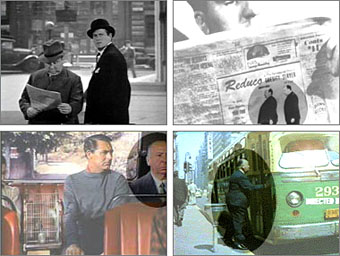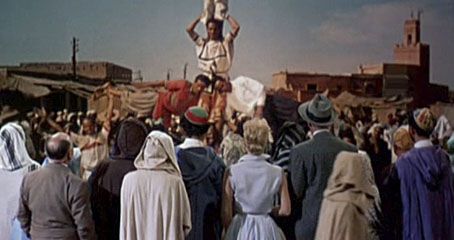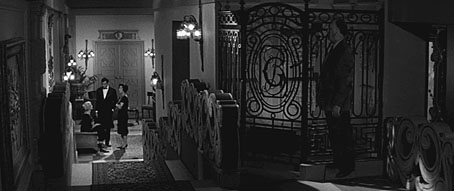top left: The Foreign Correspondent; right: Lifeboat.
bottom left: To Catch a Thief; right: North by Northwest.
Watching Alfred Hitchcock’s remake of his own The Man Who Knew Too Much this evening I realised I’d missed the director’s customary cameo appearance, and furthermore didn’t remember which scene it was supposed to be in. One of my film books lists all the cameo spots but better than that are websites such as this one that show you the actual shots.
The Man Who Knew Too Much (1956).
For the record his appearance in The Man Who… is in the crowd at a Marrakech market with his back to the camera, so he’s easier to miss than in other films from this period.
Last Year in Marienbad (1962).
And while we’re on the subject, mention should be made of Hitchcock’s appearance in Alain Resnais’s Last Year in Marienbad, a film he had nothing to do with. A brief shot shows a cardboard cut-out of the director in a hotel corridor and the way the figure is positioned always makes me think he’s floating above the floor. The timing of the appearance is apt—11 minutes in—since Hitchcock always put his cameos near the beginning of the film so as not to distract the audience later on.
Previously on { feuilleton }
• Alex in the Chelsea Drug Store
• Borges in Performance




hi john, i agree with you completely. hitch is my personal God since i was a child, I have every work published on his art since 20 years, probably the biggest private bibliography in Italy. a pleasure to see him qoted here.
My appreciation has waxed and waned. He was the first director I became aware of as a presence behind the camera when my father pointed out the shots of the feet at the beginning of Strangers on a Train as being “typical Hitchcock”. Later on my mother made me watch Psycho (a boy’s best friend is his mother!) and I was lucky to watch that completely unaware of its plot twists or even of the shower scene. The Birds too was a completely shattering experience the first time I saw it, and I still regard it as a first rate horror film.
After that I became rather obsessed with his films then had something of a reaction against them for a while, probably because by that point they seemed over-familiar. Rear Window is my favourite these days, and I watched that again this week.
I’ve had arguments in the past with people who see his films simply as empty thrillers. I usually defend them on two levels: first as exercises in pure film technique using the thriller as content; people seem to find this an odd idea in cinema yet it’s exactly like Picasso using the same theme over and over as a means to try something new. Francois Truffaut’s book of interviews with Hitchcock is essential reading.
The second level is the view of the world they portray which is of a completely malevolent universe. You see this at its purest in The Wrong Man where Henry Fonda has his life turned upside down by complete chance. Many of his films are as downbeat and pessimistic as HP Lovecraft’s stories; both artists transcend the genres they were working in.
yes i can see similarities as you say in Hitch and Lovecraft, the early Hitch mute ones are an example (see the ring, downhill, the manxman) but also going on through the 40’s (the original ending of Suspicion), the 50’s (yes, the wrong man but also vertigo) up to the birds, psycho in 60’s.
I still watch an Hitch almost every week, and what amazes me is i am able to find every time something new, a different key. He was not only a good craftsman in movies, he has been a genious and so many film of today are in debt with his work. we have to thank Truffaut book, which I am pleased to own in original first print in french, english and italian, and the book of Rohmer and Chabrol if the world changes its mind on Hitch. Not mentioning the tecnical inventive he was able to achieve…Hitch is cinema at the purest art, technical achievment, different levels of reading but still and always great entertainment.
I’ve only ever seen bits of his silent films which is surprising since I’ve watched a lot more silent cinema than most people.
If you like Hitchcock, I’d recommend Michael Powell’s Peeping Tom (if you haven’t seen that already). Powell and Hitchcock worked together in the silent days, both went off to Hollywood and Powell made some really great, imaginative films in the Forties with Emeric Pressburger.
What’s odd is that both Powell and Hitchcock came back to London eventually to make murder mysteries featuring Anna Massey (Peeping Tom and Frenzy). Peeping Tom is a fascinating film on numerous levels and one of the few films to take Rear Window’s indictment of the audience further even than Hitchcock does.
i am very familiar with Peeping Tom, thank you, and moreove with all the work of Michael Powell & Emeric Pressburger. Just to give you an idea I am currently in Mexico for business and I have with me DVDs of “A matter of life and death” and “Black Narcissus” which are both absolutely among my favorite film of the duo. Good spot on Anna Massey, I didn’t realized she was in both films.
I thought you might know Peeping Tom if you like Hitchcock, especially since it’s more well-known these days thanks to Martin Scorsese and others.
I love the Powell & Pressburger films. I’ve got a very nice but rather battered book from 1948 about the making of The Red Shoes. I keep intending to find a better copy of that some time.
i know the book you are talking about, altough i never had it in my hands. you should write something about Powell&Pressburger, if I may say, maybe on the use of colour and the cinematography of that grand old genious Jack Cardiff. Maybe linking P&P again to Hitch through him, Cardiff did Under Capricorn with Hitchcock, one of the lesser known film but in its way a great “old style” one.
Jack Cardiff, “the man who swung the great camera” as the Red Shoes book calls him. And those Technicolor cameras were great (as in huge) since they ran three strips of film through the gate simultaneously. That’s why Technicolor has that unique quality, red, blue and green were photographed individually then composited later.
The trouble for me with writing about P&P or other high level cult subjects is that they require a lot of time since a mini-essay is usually the result! And with a subject like a popular film director about whom a great deal has already been written, I often need some current relevance to give me the required energy. There’s one subject that’s film-related I’ve been wanting to write about but it’s such a cult thing for me it’ll take a lot of work to put together, especially since I’d have to source pictures and other information.
yes, I understand.
well I am looking forward to reading about this misterious cult thing of yours, and if I may be of any help with pictures please don’t hesitate to write me a mail on the subject.